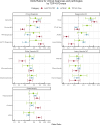Comprehensive assessment of TDP-43 neuropathology data in the National Alzheimer's Coordinating Center database
- PMID: 38896163
- PMCID: PMC11186885
- DOI: 10.1007/s00401-024-02728-8
Comprehensive assessment of TDP-43 neuropathology data in the National Alzheimer's Coordinating Center database
Abstract
TDP-43 proteinopathy is a salient neuropathologic feature in a subset of frontotemporal lobar degeneration (FTLD-TDP), in amyotrophic lateral sclerosis (ALS-TDP), and in limbic-predominant age-related TDP-43 encephalopathy neuropathologic change (LATE-NC), and is associated with hippocampal sclerosis of aging (HS-A). We examined TDP-43-related pathology data in the National Alzheimer's Coordinating Center (NACC) in two parts: (I) availability of assessments, and (II) associations with clinical diagnoses and other neuropathologies in those with all TDP-43 measures available. Part I: Of 4326 participants with neuropathology data collected using forms that included TDP-43 assessments, data availability was highest for HS-A (97%) and ALS (94%), followed by FTLD-TDP (83%). Regional TDP-43 pathologic assessment was available for 77% of participants, with hippocampus the most common region. Availability for the TDP-43-related measures increased over time, and was higher in centers with high proportions of participants with clinical FTLD. Part II: In 2142 participants with all TDP-43-related assessments available, 27% of participants had LATE-NC, whereas ALS-TDP or FTLD-TDP (ALS/FTLD-TDP) was present in 9% of participants, and 2% of participants had TDP-43 related to other pathologies ("Other TDP-43"). HS-A was present in 14% of participants, of whom 55% had LATE-NC, 20% ASL/FTLD-TDP, 3% Other TDP-43, and 23% no TDP-43. LATE-NC, ALS/FTLD-TDP, and Other TDP-43, were each associated with higher odds of dementia, HS-A, and hippocampal atrophy, compared to those without TDP-43 pathology. LATE-NC was associated with higher odds for Alzheimer's disease (AD) clinical diagnosis, AD neuropathologic change (ADNC), Lewy bodies, arteriolosclerosis, and cortical atrophy. ALS/FTLD-TDP was associated with higher odds of clinical diagnoses of primary progressive aphasia and behavioral-variant frontotemporal dementia, and cortical/frontotemporal lobar atrophy. When using NACC data for TDP-43-related analyses, researchers should carefully consider the incomplete availability of the different regional TDP-43 assessments, the high frequency of participants with ALS/FTLD-TDP, and the presence of other forms of TDP-43 pathology.
Keywords: Alzheimer’s disease; Amyotrophic lateral sclerosis; Dementia; Frontotemporal lobar degeneration; Hippocampal sclerosis of aging; Limbic predominant age-related TDP-43 encephalopathy neuropathologic change; National Alzheimer’s coordinating center; TDP-43.
© 2024. The Author(s).
Conflict of interest statement
The authors have no conflict of interest to report.
Figures






References
-
- Agrawal S, Leurgans SE, James BD, Barnes LL, Mehta RI, Dams-O'Connor K, et al. Association of traumatic brain injury with and without loss of consciousness with neuropathologic outcomes in community-dwelling older persons. JAMA Netw Open. 2022;5:e229311. doi: 10.1001/jamanetworkopen.2022.9311. - DOI - PMC - PubMed
-
- Agrawal S, Yu L, Nag S, Arfanakis K, Barnes LL, Bennett DA, et al. The association of Lewy bodies with limbic-predominant age-related TDP-43 encephalopathy neuropathologic changes and their role in cognition and Alzheimer's dementia in older persons. Acta Neuropathol Commun. 2021;9:156. doi: 10.1186/s40478-021-01260-0. - DOI - PMC - PubMed
Publication types
MeSH terms
Substances
Grants and funding
- P20 AG068053/AG/NIA NIH HHS/United States
- P30 AG066515/AG/NIA NIH HHS/United States
- P30 AG062421/AG/NIA NIH HHS/United States
- P30 AG066508/AG/NIA NIH HHS/United States
- P30 AG066519/AG/NIA NIH HHS/United States
- P30 AG066462/AG/NIA NIH HHS/United States
- P30 AG066509/AG/NIA NIH HHS/United States
- P20 AG068077/AG/NIA NIH HHS/United States
- P30 AG066546/AG/NIA NIH HHS/United States
- P30 AG072972/AG/NIA NIH HHS/United States
- P20 AG068082/AG/NIA NIH HHS/United States
- P30 AG072975/AG/NIA NIH HHS/United States
- P30 AG066444/AG/NIA NIH HHS/United States
- P30 AG066507/AG/NIA NIH HHS/United States
- P30 AG072946/AG/NIA NIH HHS/United States
- P30 AG066518/AG/NIA NIH HHS/United States
- T32AG073088/AG/NIA NIH HHS/United States
- P30 AG066511/AG/NIA NIH HHS/United States
- U24 AG072122/AG/NIA NIH HHS/United States
- P30 AG066512/AG/NIA NIH HHS/United States
- P30 AG072978/AG/NIA NIH HHS/United States
- P30 AG062429/AG/NIA NIH HHS/United States
- T32 AG073088/AG/NIA NIH HHS/United States
- P30 AG072973/AG/NIA NIH HHS/United States
- P30 AG062422/AG/NIA NIH HHS/United States
- R01 AG079280/AG/NIA NIH HHS/United States
- R01 AG062706/AG/NIA NIH HHS/United States
- P30 AG066530/AG/NIA NIH HHS/United States
- P30 AG072977/AG/NIA NIH HHS/United States
- P30 AG062677/AG/NIA NIH HHS/United States
- P20 AG068024/AG/NIA NIH HHS/United States
- P30 AG072958/AG/NIA NIH HHS/United States
- P30 AG062715/AG/NIA NIH HHS/United States
- P30 AG066506/AG/NIA NIH HHS/United States
- P30 AG066468/AG/NIA NIH HHS/United States
- P30 AG072976/AG/NIA NIH HHS/United States
- RF1 AG082339/AG/NIA NIH HHS/United States
- P30 AG072947/AG/NIA NIH HHS/United States
- P30 AG072931/AG/NIA NIH HHS/United States
- P30 AG066514/AG/NIA NIH HHS/United States
- P30 AG072959/AG/NIA NIH HHS/United States
- R01AG062706/AG/NIA NIH HHS/United States
- P30 AG072979/AG/NIA NIH HHS/United States
LinkOut - more resources
Full Text Sources
Medical
Miscellaneous

